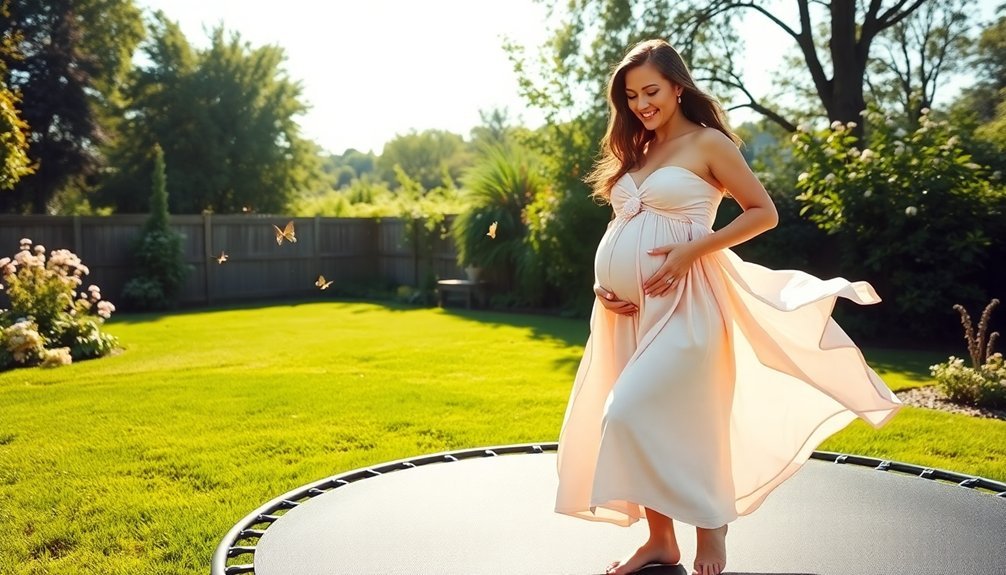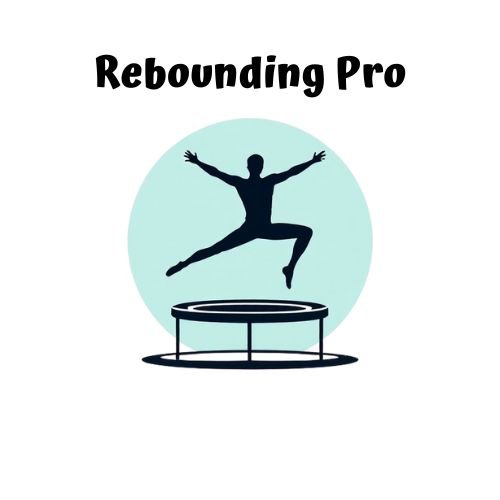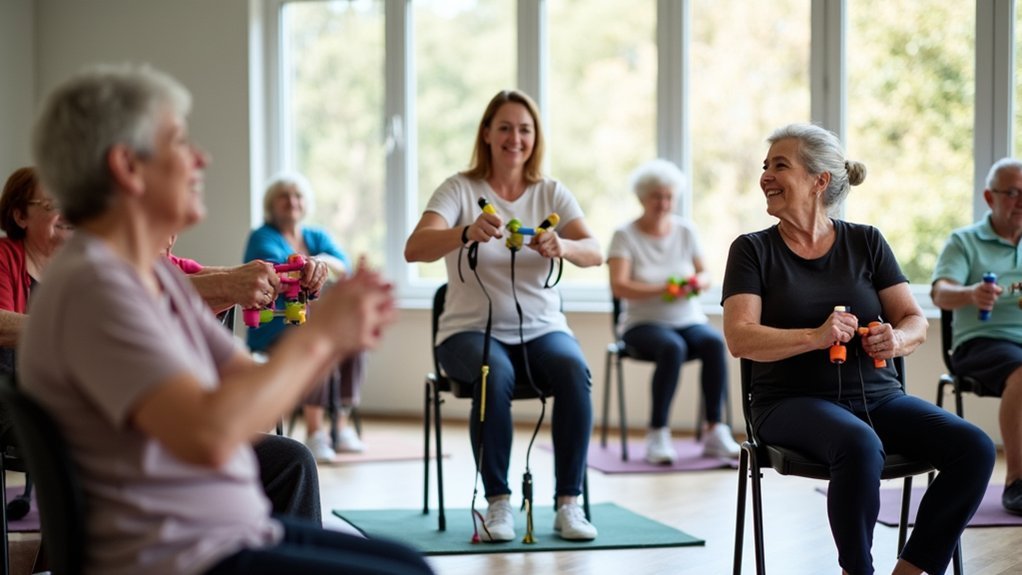Gentle trampoline rebounding during pregnancy can boost your lymphatic circulation up to 15 times normal rates, helping reduce swelling and enhance immune function. You’ll improve oxygen delivery to both you and your baby while relieving discomfort through endorphin release. Always use a mini-rebounder with support rails, focus on small, controlled movements, and adjust your routine as your pregnancy progresses. Discover how this low-impact exercise can safely transform your prenatal wellness journey.
Important Note: This article is for informational purposes only and should not be considered medical advice. Always consult your healthcare provider before starting any new exercise routine, especially if you have existing health conditions.
The Science Behind Rebounding and Lymphatic Circulation

While many exercise forms benefit pregnant women, trampoline rebounding offers unique advantages through its effect on the lymphatic system.
Unlike your cardiovascular system, your lymphatic network lacks a pump, relying on movement and muscle contractions to circulate.
When you bounce on a trampoline, the alternating weightlessness and gravitational pull creates a pumping action that opens and closes lymphatic valves. This action can increase lymph flow up to 15 times normal rates, enhancing your body’s natural detoxification processes.
The repetitive bouncing motion stimulates lymph nodes throughout your body, promoting white blood cell circulation and strengthening your immune defenses—particularly valuable during pregnancy. Gentle exercise like trampolining is crucial for maintaining proper lymphatic health during pregnancy.
This improved lymphatic circulation helps maintain fluid balance and reduces pregnancy-related swelling by efficiently removing waste and toxins from your tissues.
Safe Trampoline Techniques for Pregnancy Lymph Flow
While pregnancy requires caution with trampoline use, you’ll find gentle, controlled mini-movements on stable surfaces can support lymphatic circulation without risking falls.
You can practice subtle heel lifts or shallow knee bends while holding a secure support to maintain balance and reduce joint impact. These gentle movements stimulate the lymphatic valves, potentially enhancing lymph flow throughout your body during pregnancy.
Remember to consult your healthcare provider first, as your individual health conditions might necessitate modifications or alternative lymph-boosting exercises altogether.
Lymph-Boosting Bounce Techniques
Gentle movements on a trampoline can greatly enhance your lymphatic circulation during pregnancy. Start with 10-15 minute sessions of light rebounding several times weekly to stimulate toxin removal and reduce swelling.
Incorporate side-to-side movements while bouncing to engage larger muscle groups. Adding arm movements during your routine further promotes lymphatic circulation throughout your upper body. Using a small rebounder rather than a full-sized trampoline can be ideal as it provides better stability and control for expectant mothers.
Try weight-shifting exercises to improve balance while enhancing lymph flow in your legs. To specifically target pregnancy-related swelling, focus on lower body exercises like gentle split jumps.
Remember to maintain proper balance throughout your session and wear supportive footwear. Always keep your movements low-impact—the goal isn’t height but rather controlled, rhythmic bouncing that safely supports your changing body while maximizing lymphatic benefits.
Circulation Through Mini-Movements
Mini-movements on a rebounder offer significant circulatory benefits with minimal risk during pregnancy. You don’t need large bounces to stimulate lymphatic flow—gentle, controlled movements where your feet barely leave the surface can effectively pump lymph through your system.
Try these techniques: slight knee bends while holding a support bar, gentle side-to-side shifts, or small heel raises.
Even three 5-minute sessions daily can reduce swelling in your ankles and feet while supporting your body’s natural detoxification.
Remember to stay hydrated before and after your rebounder sessions. This enhances the circulatory benefits and prevents dizziness.
Always wear supportive footwear with proper arch support to protect your changing feet. Pregnancy significantly alters your balance due to the shifting center of gravity, making proper footwear even more essential. As your pregnancy progresses, you’ll need to adjust your stance and movements to accommodate your shifting center of gravity.
Managing Pregnancy Swelling Through Gentle Bouncing

Gentle bouncing on a trampoline can stimulate your lymphatic system, helping reduce pregnancy-related edema in your extremities.
You’ll find improved circulation as the rhythmic movement pumps blood and lymph fluid more effectively throughout your body.
To maximize swelling relief, try maintaining a consistent but gentle bouncing rhythm for 5-10 minutes at a time, always keeping one hand on a support rail for stability. However, many healthcare providers recommend avoiding trampolining altogether during pregnancy due to the increased fall risk as your center of gravity shifts throughout the trimesters.
Lymphatic Drainage Benefits
The lymphatic system plays an essential role during pregnancy, especially as your body retains more fluid. Regular trampoline exercise stimulates this system, helping to reduce swelling in your legs, ankles, and feet—common discomforts as your pregnancy progresses.
Just 10-20 minutes of gentle bouncing daily creates an effective up-and-down motion that activates lymph nodes and improves circulation throughout your body. This consistent movement helps flush toxins and excess fluids while supporting your immune function—particularly valuable during pregnancy when your body’s working overtime. Before beginning any trampoline exercise regimen, be sure to obtain doctor’s approval during the first trimester.
You’ll likely notice increased energy levels and reduced edema symptoms as your lymphatic system becomes more efficient.
For enhanced results, consider combining your trampoline routine with lymphatic massage or brushing techniques. Remember, consistency rather than intensity yields the best benefits for your pregnancy health.
Improved Circulation Techniques
Pregnancy-related swelling can become increasingly uncomfortable as you progress through your trimesters, making circulation techniques a valuable addition to your daily routine.
Gentle rebounding on a trampoline helps enhance blood and lymph flow, reducing the puffiness you might experience in your feet, ankles, and hands.
The bouncing motion works in three key ways:
- Facilitates fluid movement throughout your body, decreasing swelling and water retention
- Improves oxygen delivery to both you and your baby, supporting overall health
- Stimulates intestinal motility, helping relieve pregnancy-related constipation
This low-impact exercise supports your cardiovascular health without straining your changing body.
Remember to stay hydrated and listen to your body’s signals while enjoying these circulation benefits.
Light trampoline activity can also significantly boost your mood by releasing endorphins and alleviating PMS-related symptoms that may persist during early pregnancy.
Edema Relief Methods
Battling the uncomfortable swelling that accompanies pregnancy requires targeted strategies beyond basic circulation techniques. Up to 80% of expectant mothers experience ankle and foot swelling due to increased bodily fluids and uterine pressure.
You’ll find relief by elevating your legs above heart level whenever possible, which helps redirect excess fluid back into circulation. Physical therapists recommend manual therapy techniques that can significantly improve fluid movement in swollen areas. Wearing 15-20mmHg compression socks can greatly reduce discomfort by moving fluid into your bloodstream.
While trampolining isn’t generally recommended during pregnancy, gentle alternatives like walking or swimming effectively improve lymphatic function.
Stay hydrated with 8-10 cups of water daily to flush excess sodium and reduce retention. For immediate comfort, try soaking your feet in cool water and wearing supportive footwear.
Remember that sudden or severe swelling warrants immediate medical attention as it may indicate complications.
Trampoline Exercise for Immune Support During Pregnancy

While many expectant mothers focus on physical fitness and weight management, trampoline exercise offers a unique benefit that’s often overlooked: immune system support.
During pregnancy, your immune system faces additional challenges, making this benefit particularly valuable.
Pregnancy places unique demands on your immune defenses, making activities that enhance immunity especially important during this time.
Low-impact trampolining can enhance your immune function through:
- Improved blood circulation, which helps transport immune cells throughout your body more efficiently
- Reduced stress levels, preventing the negative impact that stress hormones have on your immune response
- Enhanced hormonal balance, helping to regulate the complex changes your body experiences during pregnancy
Remember to consult your healthcare provider before starting any trampoline routine.
While immune benefits exist, you’ll need to balance them against safety considerations, particularly regarding balance challenges and the potential impact on your pelvic floor. Trampoline jumping during pregnancy significantly increases fall risk which is specifically cautioned against by medical organizations.
Comparing Rebounding to Other Prenatal Lymphatic Exercises
When it comes to supporting your lymphatic system during pregnancy, not all exercises offer equal benefits. Rebounding on a trampoline provides considerably more intense lymphatic stimulation than many alternatives, making it particularly effective for reducing pregnancy-related swelling.
While self-lymphatic drainage techniques and joint flexion exercises are beneficial, they don’t engage large muscle groups as thoroughly as rebounding does. Deep abdominal breathing enhances lymphatic flow but works best when combined with physical movement.
You’ll find rhythmic activities like swimming also support lymphatic health, but trampolining creates a unique gravitational effect that maximizes fluid circulation. The increased blood volume during pregnancy often leads to fluid retention issues that can be effectively addressed through regular rebounding sessions.
For best results, consider a holistic approach—combine rebounding with breathing exercises and dietary support, always adjusting intensity to your pregnancy stage and consulting your healthcare provider before starting any new routine.
Adapting Your Rebounding Routine Through Each Trimester
As your pregnancy progresses through its distinct phases, your rebounding routine should evolve accordingly to accommodate your changing body and safety needs. Your balance and stability will change greatly over nine months, requiring thoughtful adjustments to your trampoline exercises.
1. First Trimester: Stick to low-impact bouncing and reduce intensity due to increased miscarriage risk and hormonal changes that may cause dizziness. The risk of falling while trampolining could potentially harm your baby during this crucial developmental period.
Listen to your body’s signals.
2. Second Trimester: Use stability aids like a T-bar as your center of gravity shifts.
Focus on low-intensity movements that maintain joint mobility without jarring impacts.
3. Third Trimester: Prioritize balance exercises while further reducing bounce height.
Consider enclosed trampolines exclusively and incorporate stretches that can help manage sciatica.
Always consult your healthcare provider before continuing or modifying your rebounding practice.
Physician-Approved Trampoline Workouts for Expectant Mothers
Now that you’ve learned how to adapt your routine across trimesters, let’s explore specific workouts that have received medical endorsement.
Always consult your healthcare provider before beginning any trampoline exercise during pregnancy.
Medical clearance is essential before incorporating any trampoline activities into your prenatal fitness routine.
For a safe, effective workout, try gentle jogging in place on a mini-rebounder with safety rails. This low-impact activity improves circulation while reducing joint stress. Indoor mini-trampolines provide greater stability and significantly reduce your risk of falling during pregnancy workouts.
Walking in place on your trampoline can maintain cardiovascular fitness without jarring movements.
Incorporate controlled, low-intensity bouncing to improve balance and coordination. These exercises can boost your mood and reduce pregnancy fatigue.
Remember to stretch thoroughly before and after your session.
Avoid high-impact exercises completely—no jumping jacks, tricks, or intense bouncing.
Always use enclosed trampolines with padded edges and follow weight guidelines for your safety.
Frequently Asked Questions
Can Rebounding Help With Morning Sickness During Pregnancy?
There’s no specific evidence that rebounding directly helps morning sickness. While it’s a low-impact exercise that can improve your overall well-being during pregnancy, you’ll need to consult your healthcare provider before trying it.
Is Trampolining Safe After a Previous Miscarriage?
After a previous miscarriage, you shouldn’t trampoline during pregnancy. It poses risks of falls and abdominal trauma. Instead, consult your healthcare provider for safer exercise options that won’t increase your pregnancy risks.
How Does Rebounding Affect Pelvic Floor Muscles During Pregnancy?
Rebounding can weaken your pelvic floor during pregnancy as it adds pressure to already softened muscles. You’ll need to engage properly and bounce gently if you’re cleared by your doctor to try it safely.
Can Partners Safely Share a Trampoline With Pregnant Women?
You can share a trampoline with your pregnant partner, but guarantee you’re gentle, avoid direct contact, use an enclosed model, and maintain supervision. Remember to prioritize low-impact movements and respect her space.
Will Rebounding Increase the Risk of Premature Labor?
Yes, rebounding can increase your risk of premature labor. The repetitive bouncing creates pressure on your uterus, potentially triggering contractions. It’s best to avoid trampolines during pregnancy for your baby’s safety.
In Summary
You’ve discovered how rebounding safely supports your pregnancy journey through improved lymphatic flow, reduced swelling, and immune system enhancement. By adapting your trampoline routine to each trimester and following physician-approved techniques, you’re giving yourself and your baby significant health benefits. Remember, always listen to your body and consult your healthcare provider before starting any pregnancy exercise program, including gentle bouncing workouts.





Leave a Reply